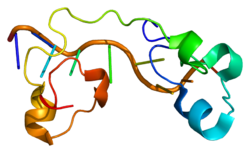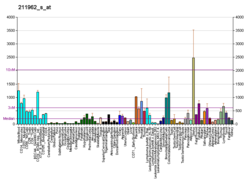ZFP36L1
Butyrate response factor 1 is a protein that in humans is encoded by the ZFP36L1 gene.[5][6]
Function
This gene is a member of the TIS11 family of early response genes. Family members are induced by various agonists such as the phorbol ester TPA and the polypeptide mitogen EGF. The gene is well conserved across species and has a promoter that contains motifs seen in other early-response genes. The encoded protein contains a distinguishing putative zinc finger domain with a repeating cys-his motif. This RNA binding protein most likely functions in regulating the response to growth factors.[6]
ZFP36L1 can degrade transcripts of numerous components of senescence-associated secretory phenotype (SASP) factors.[7][8]
Interactions
ZFP36L1 has been shown to interact with MAPK14.[9]
References
- ^ a b c GRCh38: Ensembl release 89: ENSG00000185650 – Ensembl, May 2017
- ^ a b c GRCm38: Ensembl release 89: ENSMUSG00000021127 – Ensembl, May 2017
- ^ "Human PubMed Reference:". National Center for Biotechnology Information, U.S. National Library of Medicine.
- ^ "Mouse PubMed Reference:". National Center for Biotechnology Information, U.S. National Library of Medicine.
- ^ Bustin SA, Nie XF, Barnard RC, Kumar V, Pascall JC, Brown KD, Leigh IM, Williams NS, McKay IA (Aug 1994). "Cloning and characterization of ERF-1, a human member of the Tis11 family of early-response genes". DNA Cell Biol. 13 (5): 449–59. doi:10.1089/dna.1994.13.449. PMID 8024689.
- ^ a b "Entrez Gene: ZFP36L1 zinc finger protein 36, C3H type-like 1".
- ^ Weichhart T (2018). "mTOR as Regulator of Lifespan, Aging, and Cellular Senescence: A Mini-Review". Gerontology. 84 (2): 127–134. doi:10.1159/000484629. PMC 6089343. PMID 29190625.
- ^ Papadopoli D, Boulay K, Kazak L, Hulea L (2019). "mTOR as a central regulator of lifespan and aging". F1000Research. 8: 998. doi:10.12688/f1000research.17196.1. PMC 6611156. PMID 31316753.
- ^ Rual JF, Venkatesan K, Hao T, Hirozane-Kishikawa T, Dricot A, Li N, Berriz GF, Gibbons FD, Dreze M, Ayivi-Guedehoussou N, Klitgord N, Simon C, Boxem M, Milstein S, Rosenberg J, Goldberg DS, Zhang LV, Wong SL, Franklin G, Li S, Albala JS, Lim J, Fraughton C, Llamosas E, Cevik S, Bex C, Lamesch P, Sikorski RS, Vandenhaute J, Zoghbi HY, Smolyar A, Bosak S, Sequerra R, Doucette-Stamm L, Cusick ME, Hill DE, Roth FP, Vidal M (October 2005). "Towards a proteome-scale map of the human protein-protein interaction network". Nature. 437 (7062): 1173–8. Bibcode:2005Natur.437.1173R. doi:10.1038/nature04209. PMID 16189514. S2CID 4427026.
Further reading
- Hodson DJ, Janas ML, Galloway A, Bell SE, Andrews S, Li CM, Pannell R, Siebel CW, MacDonald HR, De Keersmaecker K, Ferrando AA, Grutz G, Turner M (August 2010). "Deletion of the RNA-binding proteins ZFP36L1 and ZFP36L2 leads to perturbed thymic development and T lymphoblastic leukemia". Nat. Immunol. 11 (8): 717–24. doi:10.1038/ni.1901. PMC 2953641. PMID 20622884.
- Bell SE, Sanchez MJ, Spasic-Boskovic O, Santalucia T, Gambardella L, Burton GJ, Murphy JJ, Norton JD, Clark AR, Turner M (November 2006). "The RNA binding protein Zfp36l1 is required for normal vascularisation and post-transcriptionally regulates VEGF expression". Dev. Dyn. 235 (11): 3144–55. doi:10.1002/dvdy.20949. PMID 17013884.
- Barnard RC, Pascall JC, Brown KD, McKay IA, Williams NS, Bustin SA (July 1993). "Coding sequence of ERF-1, the human homologue of Tis11b/cMG1, members of the Tis11 family of early response genes". Nucleic Acids Res. 21 (15): 3580. doi:10.1093/nar/21.15.3580. PMC 331466. PMID 8346037.
- Maclean KN, See CG, McKay IA, Bustin SA (November 1995). "The human immediate early gene BRF1 maps to chromosome 14q22-q24". Genomics. 30 (1): 89–90. doi:10.1006/geno.1995.0014. PMID 8595910.
- Ning ZQ, Norton JD, Li J, Murphy JJ (October 1996). "Distinct mechanisms for rescue from apoptosis in Ramos human B cells by signaling through CD40 and interleukin-4 receptor: role for inhibition of an early response gene, Berg36". Eur. J. Immunol. 26 (10): 2356–63. doi:10.1002/eji.1830261013. PMID 8898945. S2CID 25669421.
- Blackshear PJ, Phillips RS, Vazquez-Matias J, Mohrenweiser H (2003). "Polymorphisms in the genes encoding members of the tristetraprolin family of human tandem CCCH zinc finger proteins". Prog. Nucleic Acid Res. Mol. Biol. Progress in Nucleic Acid Research and Molecular Biology. 75: 43–68. doi:10.1016/S0079-6603(03)75002-8. ISBN 9780125400756. PMID 14604009.
- Reppe S, Olstad OK, Rian E, Gautvik VT, Gautvik KM, Jemtland R (November 2004). "Butyrate response factor 1 is regulated by parathyroid hormone and bone morphogenetic protein-2 in osteoblastic cells". Biochem. Biophys. Res. Commun. 324 (1): 218–23. doi:10.1016/j.bbrc.2004.09.030. PMID 15465005.
- Ciais D, Cherradi N, Bailly S, Grenier E, Berra E, Pouyssegur J, Lamarre J, Feige JJ (November 2004). "Destabilization of vascular endothelial growth factor mRNA by the zinc-finger protein TIS11b". Oncogene. 23 (53): 8673–80. doi:10.1038/sj.onc.1207939. PMID 15467755.







